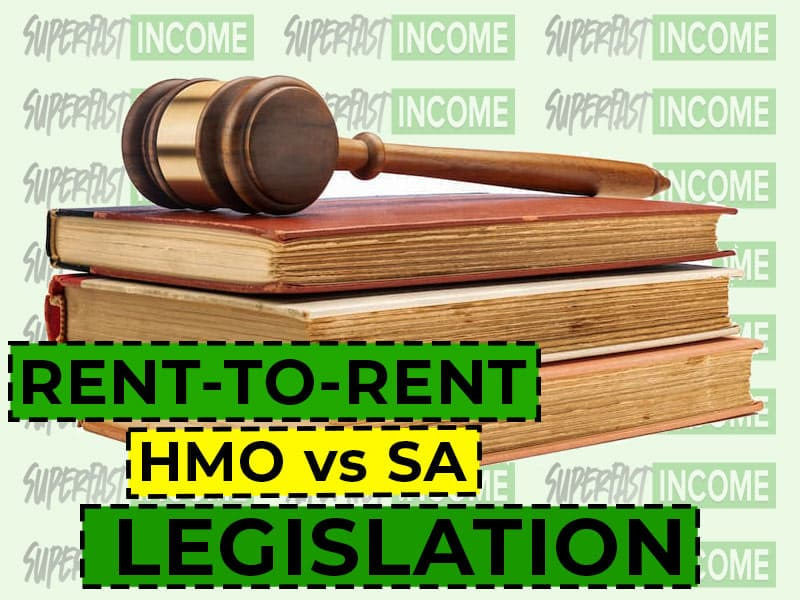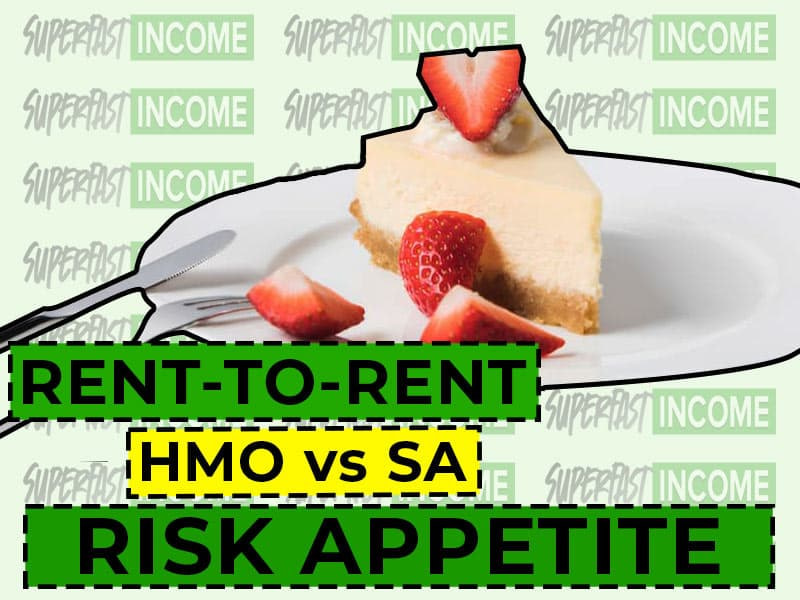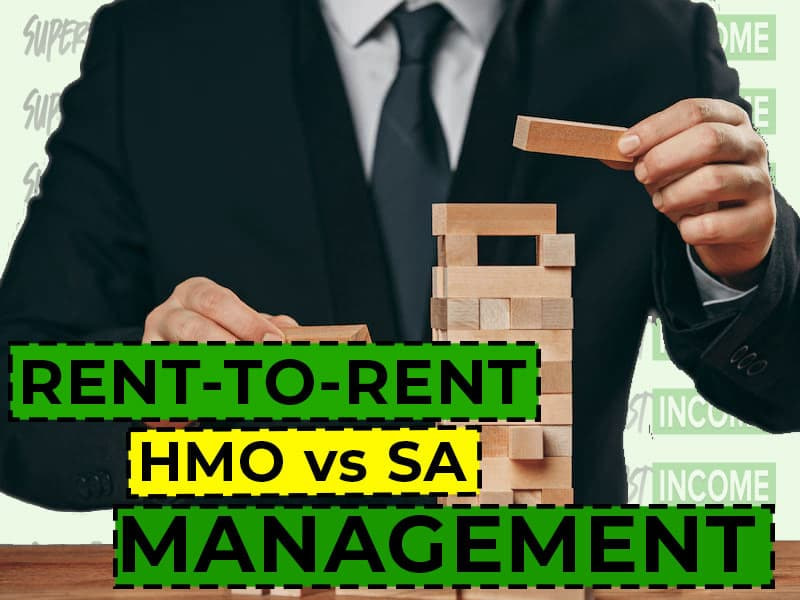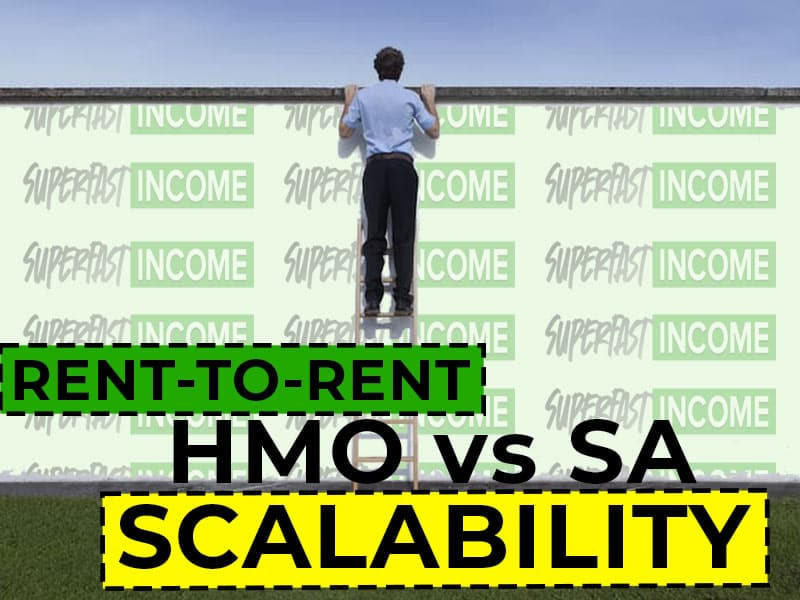When I started my Rent-to-Rent journey, I faced a big dilemma, and if you are reading this post, you may be wondering the same: What's the best strategy for rent-to-rent in the UK? Should you focus on houses in multiple occupations (HMOs) or service accommodations (SAs)?
The great news is that you don't need to spend weeks debating inside your head and researching the web as I did. In this article, I will provide you with all the information you need to make the best decision based on your specific situation and goals.
In short, HMOs may offer a more stable and predictable income with fewer expenses than service accommodations. SAs require more marketing and management but usually provide higher cash flow - Plus, it's easier to scale a portfolio of SAs than HMOs because they can be any size and are less regulated.
Now that you have a better idea of the pros and cons of both rent-to-rent strategies, let's analyse each strategy in-depth by using seven variables to simplify your decision process and help you pick the best for your specific situation.
I have selected these seven variables based on the main differences between the rent-to-rent strategies and other critical factors to keep in mind when starting any business, like startup costs. The seven variables are: legislation, risk appetite, startup costs, running costs, management intensity, cash flow, scalability.
Legislation
The legislation around rent-to-rent houses in multiple occupations (HMOs) and service accommodations (SAs) is very different in the UK. It's the first thing I want to discuss because it's an important aspect to consider when choosing your primary rent-to-rent strategy.

HMOs have been around for a long time and are heavily regulated in the UK. However, service accommodations are not regulated yet as they should be. While this is an opportunity for SA operators to operate with more flexibility, it could also represent a threat because if any restrictions come into play and this is your primary rent-to-rent strategy, your properties and business could be affected.
So, to limit the impact of possible changes in regulations, it's essential that you have break clauses in your contracts and at least two exit strategies in case SA won't be a viable option for you in the future. Ask yourself this question: If SA wasn't a viable option for this property, would I still be able to make money? If the answer is yes, then you have another exit strategy. If not, make sure you use a break clause in your contract to limit risks.
Risk Appetite
There are always risks involved when it comes to investing or starting a business. And before getting involved in any of these, it's crucial to establish your risk appetite and risk tolerance.
Let's start defining the risk appetite as the amount of risk you are willing to take to achieve your goal. Usually, in property, you will face some unexpected challenges, so things won't always go according to your plan and the risk tolerance is your acceptable deviation from the risk appetite.

If we put this into context with rent-to-rent HMOs and SAs, you will find that HMOs have less risk involved because they are highly regulated, and the minimum contract for short let is six months.
Service accommodations, on the contrary, are riskier because, in the beginning, they rely heavily on advertising and third parties platforms that you don't have control over.
Also, SAs usually require a more significant initial investment, so you have more to lose if something goes wrong. If you are risk-averse and don't enjoy the ups and downs, then HMO is a better rent-to-rent strategy. However, with more risks come rewards and Service Accommodations can accelerate the achievement of your property goals if you are up for the ride.
Startup Costs
When you target HMOs for your rent-to-rent business, you usually work with landlords already running HMOs. So, there is not much to invest in the property compared to a service accommodation.

Because, with SA, you are effectively converting a residential property into a little boutique hotel, so you usually need more initial capital to cover this cost and the voiding period during your light refurbishment.
Wherever possible, try negotiating a free rent period with the landlord to carry out the cosmetic refurbishment to reduce the startup costs.
Not every landlord will grant it, but it's always worth trying. On some occasions, you may find landlords offering to cover the refurb costs or split it with you because they see the value in upgrading their property to get better tenants for a more extended period.
It's an ideal win-win-win situation where the landlord usually gets higher rent, you get a better property to market, and the tenants live in a better place, so they tend to stay longer and pay higher rent.
Running Costs
With everything going on with the electricity and gas bills, the running costs of your properties are now something to look into carefully because they can significantly affect your cash flow and potentially make or break a deal.

Service Accommodations are notorious for having higher running costs than houses in multiple occupations. So, let's break it down and see how this affects your profits. Let's start with the electricity and gas bills. In the SA, you may have higher usage when the property is rented and no usage when the property is empty. So, more challenging to predict than HMO.
However, this shouldn't be a problem because you charge a premium for people to stay in your Service Accommodation, so you know that your bills are fully covered anytime someone is there. In my opinion, this is a plus..
Also, you have much more flexibility in adjusting costs and reacting to the market. With SA, you can change your price at any time without the need to explain it to anyone. With HMO, the minimum short let agreement is six months.
So, if you agree to rent your property with all the bills included and the price of gas and electricity starts to skyrocket, there is nothing you can do immediately. Sure, you could ask your tenants for some sympathy - but it's usually not a great strategy to run a profitable business.
Now, one thing you could do with your HMOs to compete with Service Accommodations is to include the bills in the rent but limit them to fair usage. It means you can have more control over your expenses because you put a ceiling on them. Your tenants cover everything above the agreed fair usage.
The next utility I want to cover is the internet because everyone today needed it in some capacity. And, it doesn't matter if you run a Service Accommodation or an HMO; you have higher chances to rent your property faster if you have fast broadband.Because you have one contract per property, the cost doesn't change between HMO and Service Accommodation.
So, where is the big discrepancy in costs that everyone is talking about between service accommodations and house in multiple occupations?
- Linen and towels washing or replacement (the guests can cover these costs)
- Cleaning (the guests can cover these costs)
- OTA / booking fees (typically 15% charges)
- Channel Manager (starting at $15 per month +1% commission)
So, as you can see, service accommodations usually have higher running costs, but it's not massively different from HMOs if you optimise them. Meaning you pass these costs to your guests. And usually, the more units you have, the easier it is for you to optimise the expenses because the economies of scale kick in, and you have cost advantages due to your scale of operations.
Management
Usually, people get into property because they dream of having their money work for them while enjoying a passive income stream flooding into their bank account.
When you run a Rent-to-rent business, it's actually you making the passive income dream a reality for property investors while you take care of everything for them. It's not an investment strategy but a business model, and I discussed it more in-depth in another article.

So, rent-to-rent is not passive, but different strategies may require extra effort. Service Accommodation may need more of your time in the beginning before you systematise and scale your operations, while HMOs are usually less time intensive to manage.
When you run Service Accommodations, you usually have multiple guests staying at your property during a month. You need to organise the cleaning and linen every time someone leaves. On the contrary, HMOs' tenants stay longer and require less intensive management.
If you don't have much time because you are still in your full-time job and running a rent-to-rent business is your side hustle, HMOs are usually a better strategy to start with.
However, something to consider with HMOs is that you are effectively managing multiple personalities living under the same roof, which could be pretty challenging and time-consuming if tenants start to have conflicts and you are the one called to solve them.
Cash Flow
In every business, cash flow is king, and rent-to-rent service accommodation is a powerful strategy that generates high cash flow. However, never forget that at the end of the day is what you keep in your pocket that matters - profits! The expenses for running a service accommodation are notorious for being very high.

Managing HMOs can sometimes leave you with the same, if not more, profits. So make sure you get your numbers right. It's about your specific skills, situation and ability to maximise profits. That's why some landlords will decide to let you manage their property because they don't want the hassle. Or they are struggling to make consistent profits.
Scalability
In the UK, you need a license to run an HMO. And more and more cities are introducing ART.4, which removes permitted development rights in relation to change of use from dwelling houses to houses in multiple occupations, it's more complicated to obtain new HMOs' licenses.

It means that the number of HMOs is more limited compared to Service Accommodations (SAs), which don't need a license at the time of writing this article.
So, regarding scalability, the service accommodation model is the winner here. Still, it comes with the risks of future interventions from the government as the business model becomes more popular and established.
As you scale your rent-to-rent business, I suggest keeping a balanced portfolio between service accommodations and the house in multiple occupations to reduce risks and optimise your cash flow.